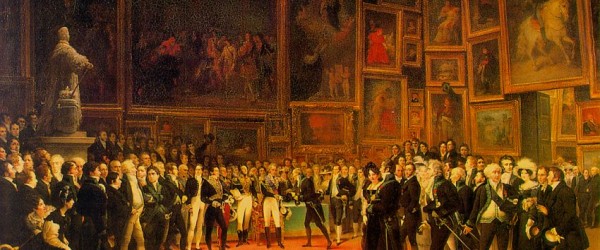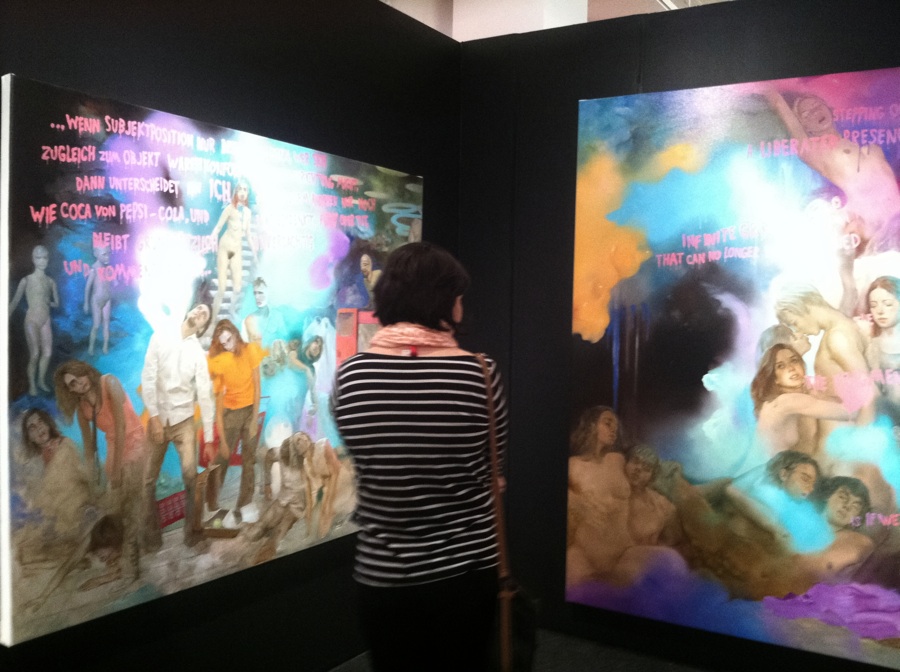
Three Fairs in Two Days: Making Sense of Armory Arts Week
Art, Art NewsIs there such a thing as an art hangover? After exploring over 300,000 square feet of paintings, video art, installations, sculptures and performance, I think I might have one.
For the New York art-lover, Armory Arts Week is as exhausting as it is exciting. March marks that time of the year when the enormous Armory fair comes to the city, bringing with it an array of satellite fairs spread all over Manhattan. Among these are Scope and Volta NY, which both feature galleries from around the globe. With limited time on my hands, I decided to visit all three fairs in the span of a weekend.
First on my list was Scope. Known for exhibiting lesser-known and emerging artists, Scope is perhaps the least-traditional of all the fairs. The most notorious installation from last year’s fair was by artist Richie Budd and featured a Plexiglas box filled with live fraternity boys getting progressively more and more drunk. This year, although I was looking forward to seeing some of the same zany artwork and installations, Scope seemed toned-down. The fair was obviously smaller in scale, a little less crazy and maybe even a little dull. The most irreverent works on display poked innocent fun at art history and art itself. At Galerie SAS, Laurent Craste’s “Iconocrash” sculptures showed a selection of bent and melted porcelain vases stabbed with nails and chiseling tools. Chad Wys made a similar riff on the value placed on traditional art objects with his graffitied, pastoral landscapes.
Next on my list was the Armory, which took up two massive exhibition spaces on Piers 92 and 94. Even though I arrived with ample time before closing, I found myself frantically buzzing through gallery booths, running past works by eminent artists like Barbara Kruger and Chuck Close in an effort to see everything.
Although the Armory showcased more mainstream galleries than those at Scope, much of the artwork on display was extremely inventive. At Upstream gallery, there was a remarkable walk-in hut, which Rob Voerman constructed from cardboard and other refuse. Despite its post-apocalyptic appearance, the hut’s title, “Dawn of a New Century,” pointed to the prospect of hope and lucidity in destruction. Upon entering the dilapidated structure, it became apparent that the dark, green windows surrounding the hut were made of one-way glass. This created an eerie effect and an unexpected experience. From the outside of the hut, the inside is almost completely obscured. But once I entered, I could see with perfect clarity the faces of onlookers peering through the windows.
After making my way through the contemporary art section, I moved on to the Armory’s display of modern art. Here, I saw breathtaking collections of Picasso drawings, small Cezannes and a few Warhols. I also caught glimpses of some of Tom Wesselman’s “steel drawings,” scattered throughout the galleries depicting nude female torsos and colorfully constructed still-lifes.
Day two of my journey was devoted to Volta NY, which turned out to be my favorite fair experience. Specifically tailored so that each gallery exhibited the work of only one artist, Volta was focused and easy to explore. Volta also had an impressive selection of emerging artists from all over the world.
Life-size firecracker sculptures by the German artist Carl Emmanuel Wolff, represented by Schuebbe Projects, drew crowds—and for good reason. Wolff’s firecracker people stood arranged in a group, holding golf clubs as if they were waiting their turn on the green. Made of bright red explosives, the figures had a raw and palpable energy.
Although it’s impossible to summarize all the artwork from Armory Arts Week, it’s fair to say that there were a few trends that kept popping up. Neon lights were unavoidable at all three fairs. They were absolutely everywhere—spelling out witty phrases, asking rhetorical questions and even being fashioned into three-dimensional objects.
Another repeated motif was American flags. At Scope, Global Art Group’s David Datuna constructed an American flag from red, white, and blue collage. An overlay of clear eyeglasses magnified small images of pop and American icons like Britney Spears and the statue of liberty. Jeremy Dean’s deconstructed flag graced Volta’s walls and looked as if it was made of melting tar. Here, the flag’s stars and stripes drooped and sagged, covered in black ooze. In both Datuna and Dean’s works, a prominent symbol of country and identity is dismantled, questioned and reconfigured as something else entirely.
When I first entered Volta, another visitor turned to me and said, “So much art, so little time!” He couldn’t have been more right. I would have happily spent days at each fair, wandering through again and again. While Armory Arts Week is essentially designed for collectors and galleries to buy and sell artwork, it’s also a marvelous opportunity for visitors to catch a glimpse of miles and miles of exciting art.
photos: Michelle Longo































